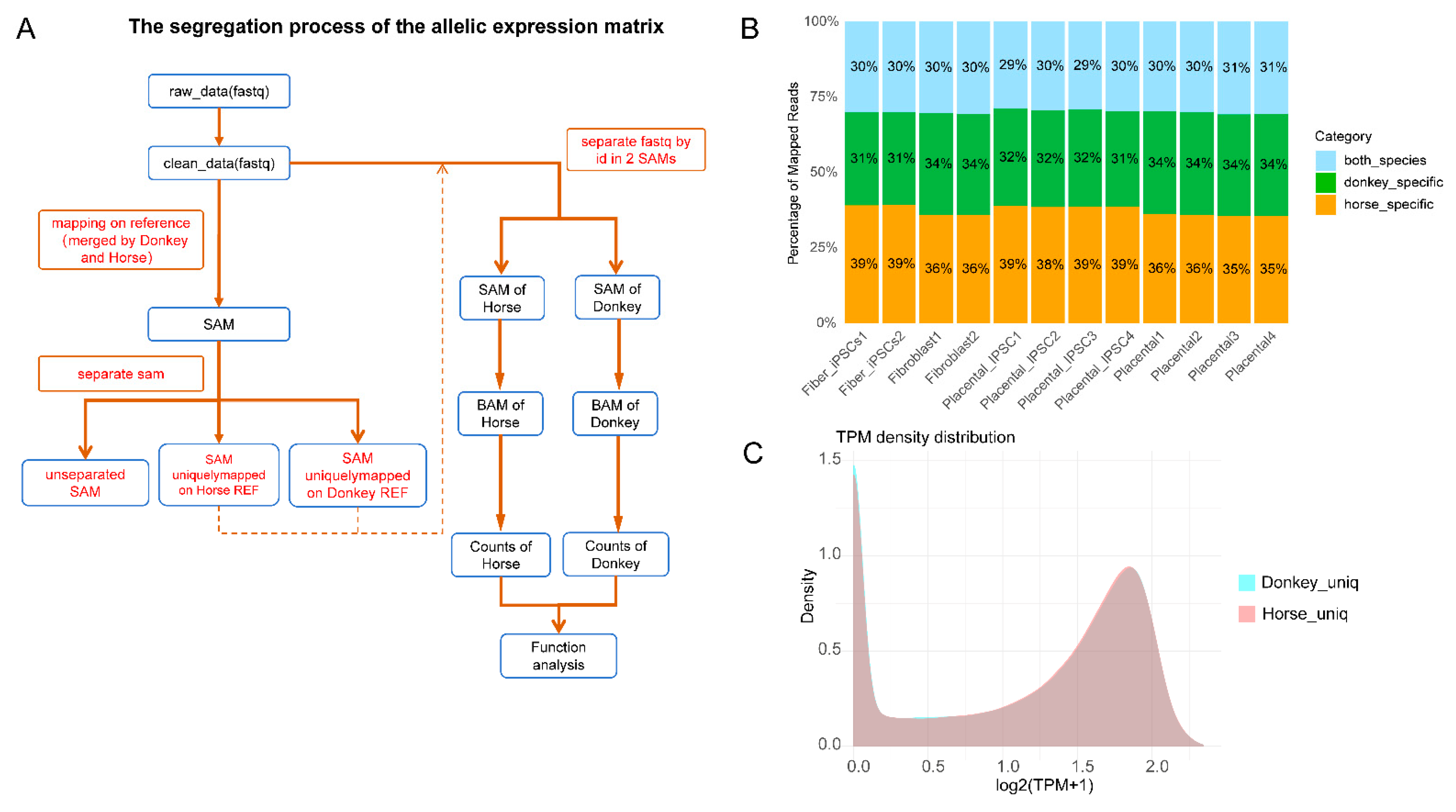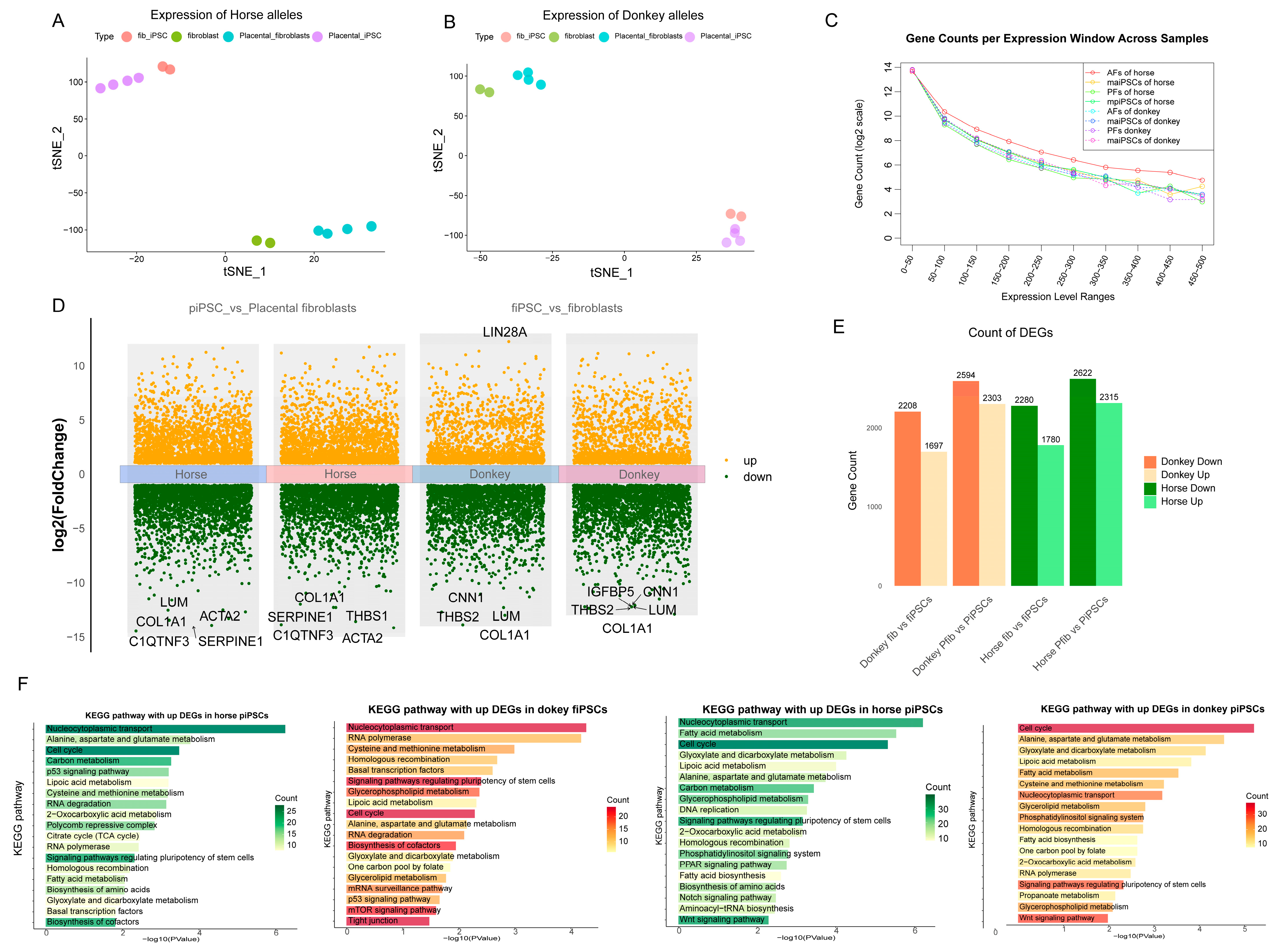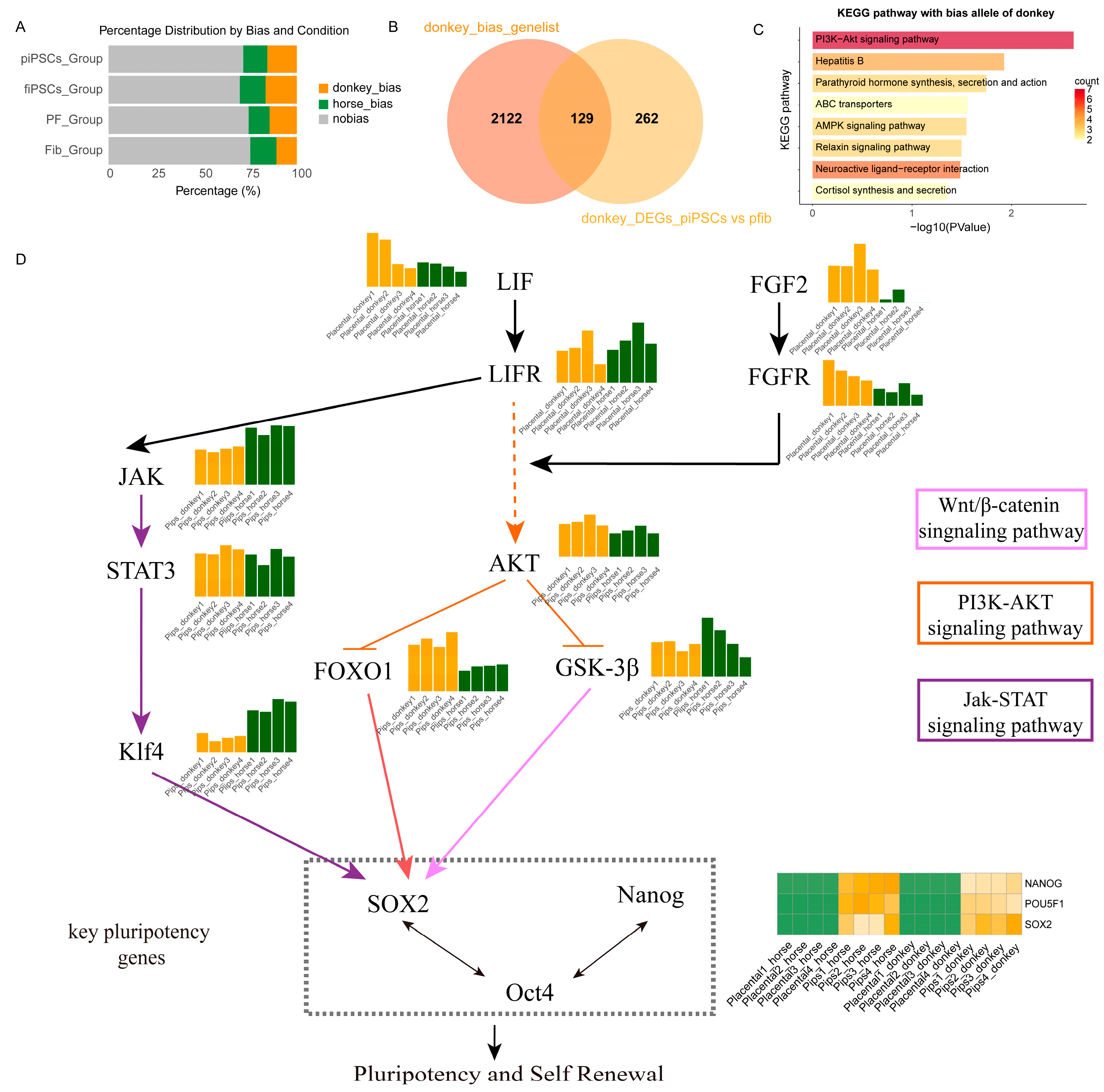1. Introduction
As interspecific hybrids of horses (
Equus caballus) and donkeys (
Equus asinus), mules (
Equus mulus) demonstrate distinct hybrid vigor, manifesting superior traits including enhanced musculoskeletal endurance, cognitive performance, adaptive thermogenesis, and innate immune competence compared to their parental species [
1]. This phenotypic superiority, coupled with their obligate sterility stemming from diploid (2
n = 63) chromosomal imbalance, positions mules as a unique biological system for investigating speciation barriers, meiotic recombination dynamics, and parent-of-origin genomic regulations [
2,
3]. The emergence of induced pluripotent stem cell (iPSC) technology has revolutionized comparative genomic studies in equids, enabling the derivation of pluripotent lineages from mule somatic tissues while bypassing ethical constraints associated with embryonic manipulation [
4,
5,
6]. This approach facilitates unprecedented investigation of hybrid cellular physiology, epigenetic memory retention, and species-specific adaptation mechanisms. Nevertheless, fibroblast reprogramming efficiency remains constrained by intrinsic metabolic and proliferative limitations inherent to equid cells. Paradoxically, recent transcriptomic analyses reveal that mule-derived somatic cells achieve significantly higher reprogramming competency than those from either parental species, suggesting that hybrid genomes may harbor unique regulatory configurations that optimize pluripotency induction—a phenomenon challenging conventional assumptions about hybrid cellular plasticity [
4]. These findings establish mule iPSCs as powerful tools for dissecting interspecies genomic interactions while providing unprecedented opportunities for conservation-oriented cellular engineering in endangered equids.
ASE analysis serves as a powerful tool for deconvoluting cis-regulatory architectures by quantifying transcriptional divergence between parental alleles within hybrid genomes [
7,
8,
9]. In interspecific hybrids like mules, ASE profiling enables systematic identification of evolutionarily conserved regulatory elements, species-specific epigenetic modifications, and parent-of-origin effects governing cellular phenotypes [
7].
In interspecies hybrids such as rice, and mules, the emergence of ASE patterns is orchestrated by an intricate interplay of regulatory mechanisms, encompassing parent-of-origin epigenetic modifications like differential DNA methylation at imprinting control regions [
10,
11]; cis-trans regulatory divergences arising from species-specific transcription factor binding affinities [
12]; and structural genomic variations, including chromosomal rearrangements and copy number variations [
13]. These multifaceted regulatory conflicts precipitate transcriptional disharmony between the horse and donkey genomes within mule cells, manifesting as coordinated suppression of metabolic pathways through H3K27me3-mediated silencing or stochastic activation of stress-responsive networks via enhancer hijacking [
4]. During the process of iPSC reprogramming, such allele-level expression imbalances erect epigenetic barriers through the incomplete erasure of somatic chromatin states at imprinted loci and the asynchronous reactivation of species-specific enhancer–promoter interactions [
9]. These molecular constraints ultimately influence reprogramming efficiency by modulating the fidelity of pluripotency network establishment, particularly impacting core regulators such as
OCT4 and
NANOG through allele-specific chromatin accessibility patterns.
Placental fibroblasts serve as a uniquely powerful model system for elucidating allele-specific regulatory conflicts in interspecies hybrids as their evolutionarily conserved ICRs maintain ancestral parental allelic expression patterns through sustained methylation at gametic differentially methylated regions, a characteristic that distinguishes them from somatic fibroblasts which acquire tissue-restricted epigenetic states during differentiation [
14]. Through establishing a comparative reprogramming research system based on mule placental and somatic fibroblasts we systematically elucidated how allelic expression imbalance affects nuclear reprogramming at the signaling pathway regulation level, specifically revealing the critical role of the PI3K-AKT signaling pathway in pluripotency remodeling, which is essential for stabilizing the pluripotency network. This research strategy reveals allele-specific differences between equine and asinine genomes at both placental and fibroblast levels and uncovers cross-species allelic expression patterns during cellular reprogramming.
In this study, using somatic and placental fibroblasts derived from mules as starting materials for reprogramming and employing our previously established induction system, we successfully generated iPSC lines from both mule somatic and placental fibroblasts. Furthermore, we conducted transcriptomic sequencing and ASE analysis on the fibroblasts and their corresponding iPSCs to explore the impact of the imbalanced expression of horse and donkey alleles on iPSC induction. This investigation not only enhances our understanding of how ASE in mule somatic cells influences their cellular biological functions but also provides critical insights into improving iPSC induction efficiency. These mechanistic insights not only redefine our understanding of hybrid cellular reprogramming but also yield an optimized protocol demonstrating a high efficiency gain over conventional methods, establishing foundational strategies for conservation-driven stem cell applications in endangered equids.
2. Materials and Methods
2.1. Reprogramming AFs and PFs to iPSCs
For this study reprogrammed cell lines from a reproductively capable mule, previously established in the laboratory, were utilized. Reprogramming studies were specifically conducted using fibroblast cell lines derived from the mule’s placenta and ear tissue [
4].
Cells cultured in M10 medium (
Supplementary Table S1) were dissociated at 70–80% confluence (~1.0 × 10
6 cells per experiment) using TrypLE Select. For t-transfection, 0.25 million cells were seeded onto mitomycin-C-inactivated STO feeder layers in DOX-supplemented M15 medium (1.0 μg/mL; 631311, Clontech, Mountain View, CA, USA) using 10 cm dishes (
Supplementary Table S1). The medium was refreshed every 48 h. Between days 10 and 14, emerging colonies were selected and maintained in the same DOX-containing medium. Reprogramming efficiency was determined by comparing colony formation in cultures treated with 2-deoxy-D-glucose (2-DG; D807272, MCE, Monmouth Junction, NJ, USA) or D-fructose-6-phosphate (F6P; MED21625, Medbio, Espoo, Finland) to untreated controls. Colonies expressing endogenous pluripotency markers (
OCT4,
SOX2,
NANOG), validated by RT-qPCR, were propagated under DOX-free conditions to establish transgene-independent iPSC lines.
2.2. Culture Conditions of maiPSCs and mpiPSCs
To optimize culture conditions, DOX-dependent iPSCs derived from AFs and PFs, expressing OCT4, SOX2, and NANOG, were plated on feeder layers at a density of 1.2 × 104 cells per well and maintained in M15 medium supplemented with DOX.
Building upon previously established mule iPSC culture protocols, a reprogramming system developed in our laboratory was employed [
4]. The culture medium was enriched with small molecules and cytokines at the following final concentrations: CHIR99021 (GSK3 inhibitor), 3 μM; PD0325901 (MEK inhibitor), 1 μM; Gö6983 (PKC inhibitor), 5 μM; SP600125 (JNK inhibitor), 4 μM; SB203580 (P38 inhibitor), 10 μM; Y27632 (ROCK inhibitor), 10 μM; SB590885 (BRAF inhibitor), 0.5 μM; WH-4-023 (SRC inhibitor), 0.5 μM; XAV939, 5.0 μM; vitamin C, 50 μg/mL; LIF, 1000 U/mL; and Activin A, 20 ng/mL. The medium was replaced daily, and surviving cells were subcultured every two days. Endogenous pluripotency marker expression (
OCT4,
SOX2, and
NANOG) was assessed after six days.
2.3. Culturing AFs, PFs, mpiPSCs, and maiPSCs
Distinct culture systems were employed for different cell types; adult fibroblasts (AFs) and placental fibroblasts (PFs) were expanded in M10 basal medium, whereas macaque- and porcine-induced pluripotent stem cells (designated as maiPSCs and mpiPSCs, respectively) required feeder layer support and underwent routine enzymatic passaging at 48–72-h intervals. The passaging procedure included: (1) medium removal followed by phosphate-buffered saline (PBS; Gibco 14, 190–144) rinsing; (2) dissociation using TrypLE Select (4 min incubation); (3) neutralization with K10 quenching medium, followed by mechanical disaggregation and cell pelleting via centrifugation (500× g, 3 min). Pelleted maiPSCs/mpiPSCs were resuspended in serum/LIF-supplemented maintenance medium for subculture. All procedures were conducted under standard mammalian cell culture conditions (5% CO2, 38.5 °C) unless otherwise specified.
For cryopreservation, cells at ~80% confluency were processed using freezing medium containing 90% fetal bovine serum (FBS) and 10% dimethyl sulfoxide (DMSO; D2650, Sigma, St. Louis, MO, USA). To ensure post-thaw viability, feeder-seeded 24-well plates (1.2 × 104 cells/well) were prepared 48 h before cryorecovery.
2.4. AP Staining
Following seeding in 4-well culture plates, cellular specimens underwent sequential processing: initial PBS (1×) rinsing, fixation with 4% paraformaldehyde (P1110-100, Solarbio, Beijing, China) under ambient conditions (10 min), and post-fixation PBS washing. Alkaline phosphatase (AP) staining was subsequently initiated by applying a freshly formulated detection solution prepared through a three-stage protocol. First, sodium nitrite solution (50 μL) was combined with FRV alkaline solution (50 μL) for thermal activation (37 °C, 3 min). This pre-activated mixture then received sequential additions of ultrapure water (2.25 mL; W1503-500, Sigma, Saint Louis, MO, USA) and naphthol-As-BI alkaline solution (50 μL), followed by vortex-assisted homogenization. The resultant working solution was dispensed onto fixed cell monolayers for 16–18 h of dark-phase incubation to enable chromogenic development.
2.5. Karyotype
Following treatment with 0.2 μg/mL colchicine for 2.5 h in culture medium, cellular samples underwent enzymatic dissociation using TrypLE Select and were pelleted via centrifugation (1300 rpm, 3 min). The harvested cells were subjected to hypotonic shock through resuspension in 8 mL 0.075 M KCl (Sigma) and incubated at 37 °C for 40 min. Sequential fixation was performed by adding 1 mL methanol–glacial acetic acid (3:1) fixative to the suspension, followed by gentle agitation and centrifugation (1000 rpm, 10 min). After supernatant removal, the pellet underwent two iterative fixation cycles in fresh fixative (8 mL each), each including 37 °C incubation for 30 min. The final cell suspension (0.5 mL fixative) was dropped onto pre-chilled glass slides, oven-dried at 70 °C for 1 h, and stained with Giemsa solution (Sigma) for 10 min. Post-staining slides were rinsed with distilled water, air-dried, and analyzed via LUCIA Cytogenetics (Prague, Czechia).
2.6. In Vitro EB Formation Assay of maiPSCs and mpiPSCs
In vitro differentiation, maiPSCs and mpiPSCs were detached from culture dishes using TrypLE Select, resuspended in M10 medium, and then seeded into ultralow cell attachment U-bottom 96-well. After 3 days in suspension culture, EBs were transferred to gelatin-coated dishes and cultured for another 3 days prior to immunostaining.
2.7. Immunofluorescence Staining
Immunofluorescence specimens underwent sequential processing: PBS rinsing, fixation in 4% paraformaldehyde (10 min, RT), and permeabilization using PBS containing 0.1% Triton X-100/1% BSA (Sigma reagents, 30 min). Primary antibody incubation proceeded at 4 °C for 16–18 h, followed by three consecutive washes (5 min each) in permeabilization buffer. Secondary antibody exposure (RT, 1 h, dark phase) was followed by post-staining cleansing: one permeabilization buffer wash (5 min) and dual PBS rinses (5 min each). Chromatin counterstaining employed DAPI (C02-04002,Bioss, Woburn, MA, USA), with confocal imaging executed on the Olympus FLUOVIEW FV1000 platform (Tokyo, Japan). Antibody specifications are cataloged in
Supplementary Table S2.
2.8. RT-qPCR Analysis
Total RNA extraction from cultured cells was performed using a RNeasy Mini Kit (74104, Qiagen, Duesseldorf, Germany). Synthesized complementary DNA (cDNA) was generated with the HiScript Q RT SuperMix (Vazyme R223-01) under qPCR-grade conditions. Target-specific primer pairs (
Supplementary Table S3) were employed for RT-qPCR amplification conducted on an Applied Biosystems Veriti 96-Well Thermal Cycler, utilizing a KAPA SYBR FAST Universal qPCR Kit (KK4601, Roche-KAPA, Basel, Switzerland). Transcript quantification involved normalization to GAPDH reference values, with fold-change calculations executed via the ΔΔCt algorithm. Experimental data are expressed as mean ± SD from technical triplicate.
2.9. RNA Library Preparation and Sequencing
Total RNA was isolated from cellular specimens using a RNeasy Mini Kit (Qiagen) per the manufacturer’s guidelines. RNA integrity assessment via a Fragment Analyzer (Advanced Analytical) preceded poly(A)+ mRNA enrichment (1–2 μg input RNA) with the NEBNext Poly(A) mRNA Magnetic Isolation Module. Libraries were constructed using a NEBNext Ultra-RNA Library Prep Kit (E7770L, Beverly, MA, USA), followed by pooling and paired-end sequencing (150-bp reads) on an Illumina NovaSeq 6000 platform (San Diego, CA, USA) with an average sequencing depth of 10× per cellular sample.
2.10. Allele-Specific Expression Analysis
To calculate allele-specific expression for mule cells deriving from horse and donkey, we first used STAR (version 2.7.11) for alignment with the following parameters:--twopassMode Basic --genomeLoad NoSharedMemory --outSAMprimaryFlag AllBestScore --outSAMmultNmax −1 --outFilterMismatchNmax 0 --outSAMattrIHstart 0 --outReadsUnmapped Fastx --outSAMattributes NH HI AS nM NM MD jM jI MC [
15]. Next, based on the mapping quality (mapq) in the generated SAM file, we determined whether each read aligned to the horse or donkey reference genome and then used a read ID file to split and reconstruct FASTQ files according to their respective reference genomes. We then realigned these source-specific FASTQ files separately to their respective references, sorted and converted the resulting SAM files to BAM files using SAMtools (V1.21) [
16], and finally performed expression quantification with StringTie (V2.2.3) [
17]. This yielded two separate allele-specific expression matrices, which were used in the subsequent analyses. Based on the quantitative results, they were converted to fragments per kilobase of transcript per million mapped reads (FPKM) for differential analysis. Differential genes were filtered with the thresholds of |log2 fold change| > 1 and
p_value < 0.05, and the differential analysis tool used was edgeR (v3.42.4).
2.11. Data Visualization Functional Enrichment Analysis
Visualization pipelines employed ggplot2 (v1.0.12) for bar/bubble plots and pheatmap (v3.3.5) for gene cluster heatmaps. Functional enrichment analyses encompassed Gene Ontology (GO) and KEGG pathway assessments using clusterProfiler (v4.1.0) [
18]. Gene set prioritization via GSEA (Broad Institute v4.0.3) [
19].
4. Discussion
Efficient iPSC reprogramming is influenced by factors such as cellular metabolism, epigenetic regulation, and cell cycle dynamics [
20,
21,
22]. In hybrid animal cells, how these factors interact with allele-specific expression to affect reprogramming efficiency remains unclear [
23]. Our results demonstrate that maiPSCs exhibit higher reprogramming efficiency than mpiPSCs, as evidenced by two key findings: (1) more iPSC colonies formed by day 14 of reprogramming; (2) higher colony establishment efficiency after two passages. This discrepancy may be attributed to the unique properties of placental fibroblasts. Using RNA-seq analysis and allele-specific expression profiling, we identified key factors influencing the lower reprogramming efficiency of mpiPSCs.
Although hybrid animal somatic cells have been shown to reprogram successfully into iPSCs in vitro, the advantages of hybrid vigor in mule iPSCs remain underexplored [
4]. In this study, by comparing mule placental fibroblasts and somatic fibroblasts we investigated the factors affecting mule iPSC reprogramming efficiency through allele-specific expression analysis. Based on RNA-seq data, we confirmed that the PI3K-AKT signaling pathway plays a critical role in the reprogramming of placental fibroblasts. The imbalance in allele-specific expression presents a barrier to achieving pluripotency. In contrast, maiPSCs displayed better adaptability in balancing allele-specific expression, which could explain their higher reprogramming efficiency. This phenomenon may be linked to epigenetic factors, as the demethylation process during reprogramming can alleviate the effects of methylation or genomic imprinting on transcriptional expression in placental cells [
24].
Furthermore, both AFs and PFs exhibited stable expression of highly activated endogenous pluripotency genes after reprogramming, indicating that mule iPSCs maintain genomic stability post-reprogramming. By comparing the allele-specific expression levels between mpiPSCs and maiPSCs, we identified 412 horse-specific differentially expressed alleles and 379 donkey-specific differentially expressed alleles which are involved in the PI3K-AKT signaling pathway and play a significant role in determining the reprogramming efficiency of mpiPSCs. Additionally, after filtering for allele-specific differences between placental and somatic fibroblasts these genes were found to be precise targets involved in epigenetic regulation in mule placental cells, under the control of genomic imprinting mechanisms.
Interestingly, during the reprogramming process maiPSCs exhibited significant activation of donkey-derived alleles, which could contribute to the higher efficiency of fibroblast reprogramming. In contrast, in placental fibroblasts donkey-derived alleles showed greater activity and were more likely to participate in placental-specific functions, such as immune regulation and maintenance of the maternal–fetal interface. These roles may limit their ability to reprogram into a pluripotent state.
In conclusion, this study highlights the differences in allele-specific expression between mule somatic and placental fibroblasts and their impact on reprogramming efficiency. The specific expression of horse and donkey alleles in different cell types largely determines the activation efficiency of pluripotency genes and the ultimate formation of iPSCs. These findings indicate that allele-specific expressions during reprogramming are influenced by multiple factors, including cell origin, reprogramming factors, and epigenetic status. This study provides new insights into the molecular mechanisms of reprogramming in mule cells and identifies potential molecular targets to improve reprogramming efficiency. Future research should further investigate the regulatory mechanisms of allele-specific expression during reprogramming, particularly how modulating allele-specific expression could enhance reprogramming efficiency.
5. Conclusions
This study successfully established and characterized induced pluripotent stem cells (iPSCs) from both adult and placental fibroblasts of mules, revealing notable differences in reprogramming efficiency. Mule adult fibroblasts exhibited higher reprogramming efficiency than placental fibroblasts, despite both iPSC types displaying comparable pluripotency markers and differentiation capacity. Through allele-specific expression (ASE) analysis, we observed a pronounced allele expression bias in placental fibroblasts favoring horse-derived alleles, which was alleviated after reprogramming. In mule placental iPSCs (mpiPSCs), although donkey-derived alleles were relatively enriched in pluripotency-related genes their expression appeared suppressed. Notably, this suppression was particularly evident in genes associated with the PI3K-AKT signaling pathway and may contribute to the lower reprogramming efficiency observed in placental fibroblasts. However, we acknowledge that our data are correlative in nature and that direct functional validation will be required to establish a causal relationship between PI3K-AKT pathway activity and reprogramming outcomes. Furthermore, our study is limited by the number of biological replicates and the absence of additional cell types from donkey and horse, which should be addressed in future investigations to strengthen and generalize our findings. Taken together, our results highlight the potential importance of allele-specific regulatory mechanisms in influencing iPSC reprogramming efficiency and provide a foundation for future research into the molecular basis underlying interspecies differences in pluripotency regulation.












